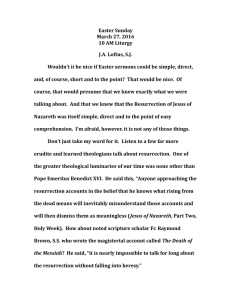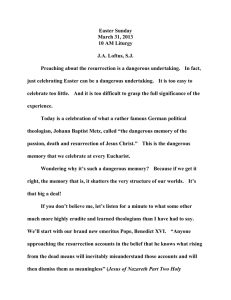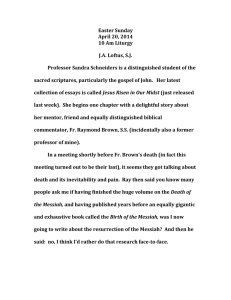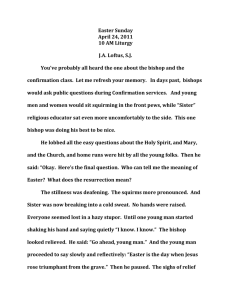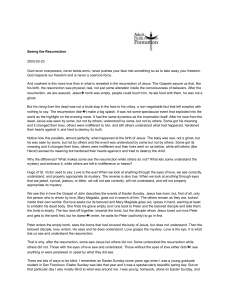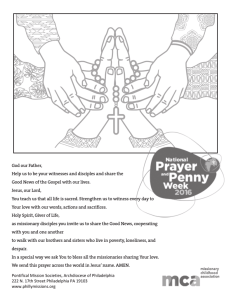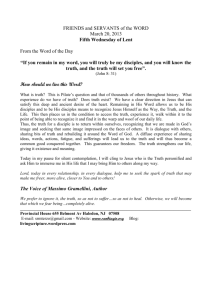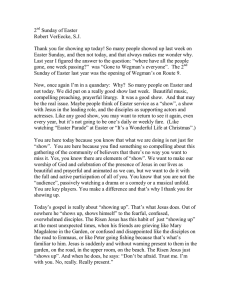1 Third Sunday of Easter, Year A May 4, 2014
advertisement
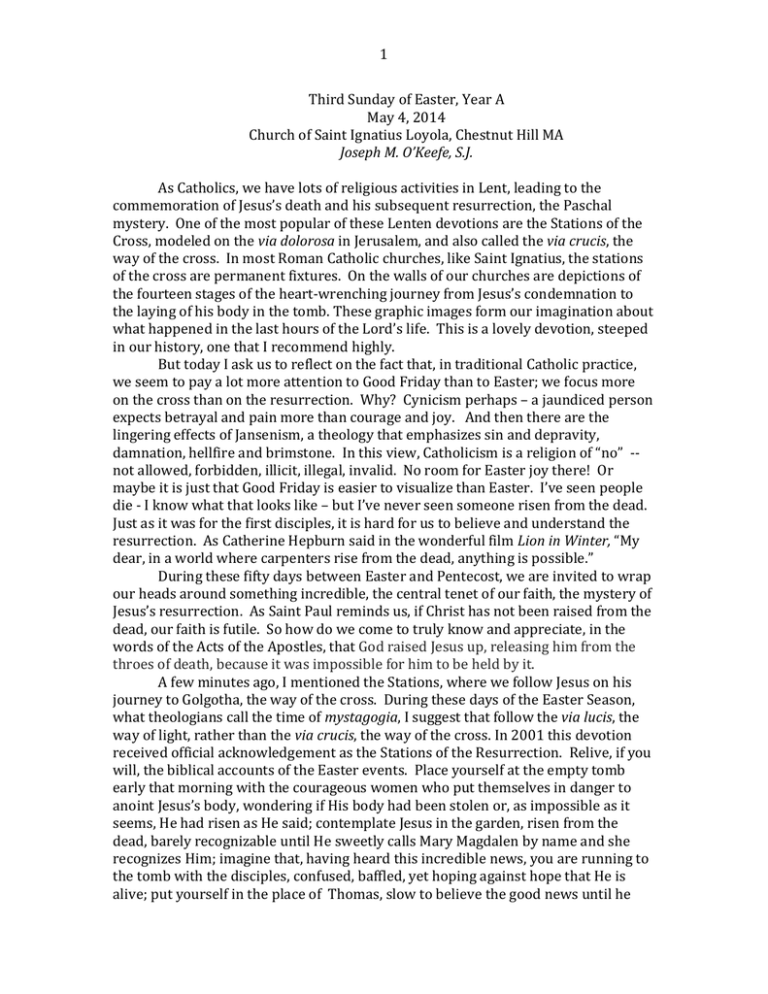
1 Third Sunday of Easter, Year A May 4, 2014 Church of Saint Ignatius Loyola, Chestnut Hill MA Joseph M. O’Keefe, S.J. As Catholics, we have lots of religious activities in Lent, leading to the commemoration of Jesus’s death and his subsequent resurrection, the Paschal mystery. One of the most popular of these Lenten devotions are the Stations of the Cross, modeled on the via dolorosa in Jerusalem, and also called the via crucis, the way of the cross. In most Roman Catholic churches, like Saint Ignatius, the stations of the cross are permanent fixtures. On the walls of our churches are depictions of the fourteen stages of the heart-wrenching journey from Jesus’s condemnation to the laying of his body in the tomb. These graphic images form our imagination about what happened in the last hours of the Lord’s life. This is a lovely devotion, steeped in our history, one that I recommend highly. But today I ask us to reflect on the fact that, in traditional Catholic practice, we seem to pay a lot more attention to Good Friday than to Easter; we focus more on the cross than on the resurrection. Why? Cynicism perhaps – a jaundiced person expects betrayal and pain more than courage and joy. And then there are the lingering effects of Jansenism, a theology that emphasizes sin and depravity, damnation, hellfire and brimstone. In this view, Catholicism is a religion of “no” -not allowed, forbidden, illicit, illegal, invalid. No room for Easter joy there! Or maybe it is just that Good Friday is easier to visualize than Easter. I’ve seen people die - I know what that looks like – but I’ve never seen someone risen from the dead. Just as it was for the first disciples, it is hard for us to believe and understand the resurrection. As Catherine Hepburn said in the wonderful film Lion in Winter, “My dear, in a world where carpenters rise from the dead, anything is possible.” During these fifty days between Easter and Pentecost, we are invited to wrap our heads around something incredible, the central tenet of our faith, the mystery of Jesus’s resurrection. As Saint Paul reminds us, if Christ has not been raised from the dead, our faith is futile. So how do we come to truly know and appreciate, in the words of the Acts of the Apostles, that God raised Jesus up, releasing him from the throes of death, because it was impossible for him to be held by it. A few minutes ago, I mentioned the Stations, where we follow Jesus on his journey to Golgotha, the way of the cross. During these days of the Easter Season, what theologians call the time of mystagogia, I suggest that follow the via lucis, the way of light, rather than the via crucis, the way of the cross. In 2001 this devotion received official acknowledgement as the Stations of the Resurrection. Relive, if you will, the biblical accounts of the Easter events. Place yourself at the empty tomb early that morning with the courageous women who put themselves in danger to anoint Jesus’s body, wondering if His body had been stolen or, as impossible as it seems, He had risen as He said; contemplate Jesus in the garden, risen from the dead, barely recognizable until He sweetly calls Mary Magdalen by name and she recognizes Him; imagine that, having heard this incredible news, you are running to the tomb with the disciples, confused, baffled, yet hoping against hope that He is alive; put yourself in the place of Thomas, slow to believe the good news until he 2 touches the wounds of Jesus; imagine that you are on the seashore with the other disciples, still reeling from the rollercoaster events of the past days, when your beloved Lord comes to share a meal with you; imagine that you are with Peter, still haunted by his cowardice, as Jesus reaffirms him and asks him to feed the sheep, to care for the flock; imagine that you are on that hillside in Galilee, listening to Jesus’s last words, accepting His commission to go to the world to announce the good news of the resurrection, to proclaim that, when all is said and done, light is more powerful than darkness, truth wins out over falsehood, love overcomes hatred, and life is victorious over death. And, listening to today’s gospel, imagine today that you are walking with those two disciples on the road to Emmaus. During these days, God invites us to consolation as we relive the experience of the first disciples, as we walk the via lucis, the way of light, the Stations of the Resurrection. The Stations of the Resurrection are practiced by the Iona Community in Scotland. Let us listen to the words of Craig Mitchell, inviting members of his Iona community to this Easter prayer: Easter is not an event that has occurred, it’s an adventure that has begun; It is not a place that we have visited, but a path on which we stand; a story not complete, but unfolding; characters still breathing, stations still teeming with the promise of new life not just for you and me but for all people, in all places; a cosmic crux, a turning point of time. Easter is the season of wild hope, of dangerous intent, of potent promise where the future flaps unfurled in the spirit’s breeze, where hopes bubble with uncorked effervescence, where toes tap to free-form rhythms, where rainbow hues splash empty canvas. Tonight we continue the journey; we re-enter the story to explore our questions, to uncover our doubts, to face our nagging need. We walk the path of two who travelled a dusty road wrapped in confusion and despair; two who shared the company of a stranger voicing their pain, airing their fears, and in the listening heard words of hope and promise, and in the eating received true bread of life Tonight we re-enter the story with the expectation that Christ will also reveal himself to us in sights and sounds, in words and symbols, in bread and in wine. We pray that He will walk with us this evening, to be our companion and guide, to be our teacher and friend, to be our host and servant bringing gifts of faith, peace, hope, and deep joy.
